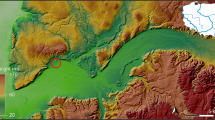Abstract
THIS communication reports an exploratory study of radioactivity in natural and cultivated vegetation. Thirty-five species of angiosperms and mosses, representative of a wide range of non-calcareous woodland, bog and fen habitats, were collected, and twenty samples of roots and tops from seven species of cultivated vegetables, near Windermere during early 1958. For a wider view, nineteen collections of the bog moss Sphagnum papillosum were made in various parts of the Lake District, and two near Garrigill and Malham in the Pennines. In addition, eleven stream and lake waters were analysed. Twenty-seven herbarium specimens of wild plants collected in the decade prior to 1947 were also examined. Their activity, due to long-lived natural isotopes, can be taken as little lower than when collected.
Similar content being viewed by others
References
Bryant, F. J., Chamberlain, A. C., Morgan, A., and Spicer, G. S., Atomic Energy Res. Estab., HP/R 2353 (1957).
Author information
Authors and Affiliations
Rights and permissions
About this article
Cite this article
GORHAM, E. Accumulation of Radioactive Fall-out by Plants in the English Lake District. Nature 181, 1523–1524 (1958). https://doi.org/10.1038/1811523a0
Issue Date:
DOI: https://doi.org/10.1038/1811523a0
- Springer Nature Limited
This article is cited by
-
Fall-out Radioactivity in Southern Sweden
Nature (1960)
-
Some calculations on radioactive fallout with especial reference to the secular variations in potential gradient at Eskdalemuir, Scotland
Geofisica Pura e Applicata (1959)
-
Deposition of Strontium-90 and its Content in Vegetation and in Human Diet in the United Kingdom
Nature (1958)





